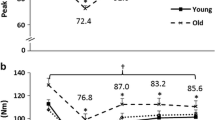Abstract
The purposes of this study were to compare the ratings of perceived exertion (RPE) of young [25 (1) years] and old men [84 (1) years] during intermittent (3 s on, 2 s off) voluntary isometric contractions of the elbow flexors at 60% of each subject's maximal voluntary contraction (MVC) force, and to determine whether potential differences in RPE were accompanied by altered neuromuscular parameters during fatigue. Subjects performed the fatigue protocol on two different visits. All subjects in both groups reported a maximal (10) perceived exertion using a modified Borg-scale at fatigue, but the old men reported a greater perceived exertion compared to the young men at an initial stage of the protocol during the two visits (P<0.05). The amount of prefatigue MVC force remaining at fatigue was not different between groups (~57%), and voluntary activation, as assessed with twitch interpolation, was not different from the prefatigue value for either group throughout the fatigue protocol (>95%), and did not show any age-related difference. Moreover, there was no significant difference in 60% target electromyography between groups at any time point during the fatigue protocol, and there was no significant effect of age on the decline in 50-Hz tetanic force. Thus, the old men were able to exert themselves to the same relative degree of muscle fatigue as the young men, and despite an elevated perceived exertion compared to the young men during initial stages of the protocol, they did not terminate the protocol prematurely, or demonstrate an inability to sustain a high level of voluntary activation.



Similar content being viewed by others
References
Allman BL, Rice CL (2002) Neuromuscular fatigue and aging: central and peripheral factors. Muscle Nerve 25:785–796
Aminoff T, Smolander J, Korhonen O, Louhevaara V (1996) Physical work capacity in dynamic exercise with differing muscle masses in healthy young and older men. Eur J Appl Physiol 73:180–185
Aminoff T, Smolander J, Korhonen O, Louhevaara V (1997) Cardiorespiratory and subjective responses to prolonged arm and leg exercise in healthy young and older men. Eur J Appl Physiol 75:363–368
Bertoni-Freddari C, Fattoretti P, Paoloni R, Caselli U, Galeazzi L, Meier-Ruge W (1996) Synaptic structural dynamics and aging. Gerontology 42:170–180
Bilodeau M, Erb MD, Nichols JM, Joiner KL, Weeks JB (2001) Fatigue of elbow flexor muscles in younger and older adults. Muscle Nerve 24:98–106
Carmeli E, Reznick AZ (1994) The physiology and biochemistry of skeletal muscle atrophy as a function of age. Proc Soc Exp Biol Med 206:103–113
Davy KP, Johnson DG, Seals DR (1995) Cardiovascular, plasma norepinephrine, and thermal adjustments to prolonged exercise in young and older healthy humans. Clin Physiol 15:169–181
Ditor DS, Hicks AL (2000) The effect of age and gender on the relative fatigability of the human adductor pollicis muscle. Can J Physiol Pharmacol 78:781–790
Enoka RM, Stuart DG (1992) Neurobiology of muscle fatigue. J Appl Physiol 72:1631–1648
Faulkner JA, Brooks SV (1995) Muscle fatigue in old animals. Unique aspects of fatigue in elderly humans. Adv Exp Med Biol 384:471–480
Gerdle B, Karlsson S, Crenshaw AG, Friden J (1997) The relationships between EMG and muscle morphology throughout sustained static knee extension at two submaximal force levels. Acta Physiol Scand 160:341–351
Hicks AL, McCartney N (1996) Gender differences in isometric contractile properties and fatigability in elderly human muscle. Can J Appl Physiol 21:441–454
Jasperse JL, Seals DR, Callister R (1994) Active forearm blood flow adjustments to handgrip exercise in young and older healthy men. J Physiol (Lond) 474:353–360
Jones NL, Killian KJ (2000) Exercise limitation in health and disease. N Engl J Med 343:632–641
Lloyd AR, Gandevia SC, Hales JP (1991) Muscle performance, voluntary activation, twitch properties and perceived effort in normal subjects and patients with the chronic fatigue syndrome. Brain 114 (Part 1A):85–98
Mattay VS, Fera F, Tessitore A, Hariri AR, Das S, Callicott JH, Weinberger DR (2002) Neurophysiological correlates of age-related changes in human motor function. Neurology 58:630–635
Mrak RE, Griffin ST, Graham DI (1997) Aging-associated changes in human brain. J Neuropathol Exp Neurol 56:1269–1275
Overend TJ, Versteegh TH, Thompson E, Birmingham TB, Vandervoort AA (2000) Cardiovascular stress associated with concentric and eccentric isokinetic exercise in young and older adults. J Gerontol A Biol Sci Med Sci 55:B177–B182
Pincivero DM, Gear WS (2000) Quadriceps activation and perceived exertion during a high intensity, steady state contraction to failure. Muscle Nerve 23:514–520
Pincivero DM, Gear WS, Moyna NM, Robertson RJ (1999) The effects of rest interval on quadriceps torque and perceived exertion in healthy males. J Sports Med Phys Fitness 39:294–299
Pincivero DM, Coelho AJ, Erikson WH (2000) Perceived exertion during isometric quadriceps contraction. A comparison between men and women. J Sports Med Phys Fitness 40:319–326
Pincivero DM, Coelho AJ, Campy RM, Salfetnikov Y, Bright A (2001) The effects of voluntary contraction intensity and gender on perceived exertion during isokinetic quadriceps exercise. Eur J Appl Physiol 84:221–226
Smolander J, Aminoff T, Korhonen I, Tervo M, Shen N, Korhonen O, Louhevaara V (1998) Heart rate and blood pressure responses to isometric exercise in young and older men. Eur J Appl Physiol 77:439–444
Stackhouse SK, Stevens JE, Lee SC, Pearce KM, Snyder-Mackler L, Binder-Macleod SA (2001) Maximum voluntary activation in nonfatigued and fatigued muscle of young and elderly individuals. Phys Ther 81:1102–1109
Taylor JA, Hand GA, Johnson DG, Seals DR (1991) Sympathoadrenal-circulatory regulation during sustained isometric exercise in young and older men. Am J Physiol 261:R1061–R1069
Wong DG, Rechnitzer PA, Cunningham DA, Howard JH (1990) Effect of an exercise program on the perception of exertion in males at retirement. Can J Sport Sci 15:249–253
Acknowledgements
This work is supported in part by the Natural Sciences and Engineering Research Council of Canada. The experiments performed comply with the current laws of Canada regarding experimentation on human subjects.
Author information
Authors and Affiliations
Corresponding author
Rights and permissions
About this article
Cite this article
Allman, B.L., Rice, C.L. Perceived exertion is elevated in old age during an isometric fatigue task. Eur J Appl Physiol 89, 191–197 (2003). https://doi.org/10.1007/s00421-002-0780-4
Accepted:
Published:
Issue Date:
DOI: https://doi.org/10.1007/s00421-002-0780-4




